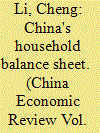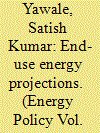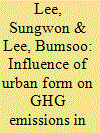|
|
|
Sort Order |
|
|
|
Items / Page
|
|
|
|
|
|
|
| Srl | Item |
| 1 |
ID:
166927


|
|
|
|
|
| Summary/Abstract |
The upward trend in the residential sector of energy use has significant consequences in terms of environmental impacts. Determining the carbon metric (CM), as part of the whole carbon footprint of a building, contributes to quantify the carbon emissions related to the building's use stage. Although many carbon footprint calculators exist in other sectors, none has been specifically designed and applicable to the building one. However, ISO 16745 provides guidelines for calculating and reporting the CM of existing buildings in operation. In this context, this work sets a methodology to measure the CM of existing households' use stage, based on ISO 16745 and split into three stages. The implementation of the methodology to a case study proved its applicability since it enabled the data collection task through the designed survey, and allowed the energy carriers and end-uses be disaggregated, quantified and clearly reported for user's knowledge. The study outlined that calculating the CM and, more specifically, reporting and making the results publicly available, help raise users' awareness about reducing greenhouse gas-related emissions, and provide new ideas for monitoring, benchmarking and proposing policies at individual member state and EU levels.
|
|
|
|
|
|
|
|
|
|
|
|
|
|
|
|
| 2 |
ID:
161874


|
|
|
|
|
| Summary/Abstract |
In this paper, we compile China's household balance sheet and apply this perspective to the analysis of household financial conditions. Specifically, we first address some technical issues on the balance sheet accounts, and detail the estimations of two important asset items, “dwellings” and “automobiles.” Next, through reading the sheets, we provide an international comparative analysis, and show: (1) China's households are still on their early stage of wealth accumulation, and this trend is associated with a changing structure in favour of financial assets. (2) Although being subject to relatively low insolvency and liquidity risks, the sector has experienced, generally contrary to major developed or emerging countries, a climbing leverage cycle since the global financial crisis. These findings imply that China's policymakers should, on the one hand, make further efforts to help households accumulate wealth with an improved structure in terms of liquidity and risk diversification, and on the other hand, need to pay high attention to the increasing household financial stress and the potential risk contagion.
|
|
|
|
|
|
|
|
|
|
|
|
|
|
|
|
| 3 |
ID:
191415


|
|
|
|
|
| Summary/Abstract |
Regional disparity and energy poverty are major challenges for India on a macro-scale. In this study we explored regional disparity and energy poverty in India's future by formulating a series of unique mathematical functions while analyzing historical time-series of per-capita energy consumption (PEC). The functions formulated have important implications on India's approaches towards rapid urbanization, access to clean energy, and rural electrification. We also analyzed end-use energy consumption in low, mid and high-developing states and examined the impacts of the uncertainty of socio-economic changes. As per our estimates, energy consumption in urban areas, is likely to grow by 3.6 times from 2010 to 2070, whereas that in rural areas is likely to decrease by 0.6 times. Energy poverty among Indian states narrows by 2050, while energy consumption in the mid and high-developing states rises rapidly as urbanization and per-capita income increase. Even with this consumption growth, India's average household PEC in 2070 may remain lower than the world average recorded in 2010. The provision of advanced energy resources and technologies is therefore likely to be an important policy challenge for India, especially in the rural areas of low-developing states, as the country pursues its target of reducing energy poverty and regional disparity.
|
|
|
|
|
|
|
|
|
|
|
|
|
|
|
|
| 4 |
ID:
166304


|
|
|
|
|
| Summary/Abstract |
Energy efficient lighting confers significant potential in electricity demand reduction. To increase the diffusion of energy efficient lighting, an LED Replacement Lamps Program is proposed. Free of charge LED lamps are suggested to be distributed to households by government to reduce household electricity demand. Because electricity is heavily subsidized in Iran, the direct benefit of the program for the government will be avoiding the energy subsidy payments. Back-of-the-envelope benefit cost analysis suggests that if potential electricity savings are realized, the program will be profitable. However, the possible rebound effect may negatively impact the program effectiveness through partially offsetting the potential electricity savings. Therefore, the viability of the program depends on the actual electricity savings that may differ from its anticipated levels. A hybrid dynamic general equilibrium model is employed to evaluate the actual economy-wide energy savings. The model has the novelty of endogenously calculating useful energy demand (e.g. lighting, cooling). Energy demand is then derived based on end-use efficiency and useful energy demand. Model results indicate an average economy-wide rebound of 43.8%. Even though the rebound value is high, the program is shown to be profitable.
|
|
|
|
|
|
|
|
|
|
|
|
|
|
|
|
| 5 |
ID:
133265


|
|
|
|
|
| Publication |
2014.
|
| Summary/Abstract |
To better understand the role of sustainable urban development in greenhouse gas (GHG) mitigation, this study examines the paths by which urban form influences an individual household×s carbon dioxide emissions in the 125 largest urbanized areas in the U.S. Our multilevel SEM analyses show that doubling population-weighted density is associated with a reduction in CO2 emissions from household travel and residential energy consumption by 48% and 35%, respectively. Centralized population and polycentric structures have only a moderate impact in our analyses. Given that household travel and residential energy use account for 42% of total U.S. carbon dioxide emissions, these findings highlight the importance of smart growth policies to build more compact and transit friendly cities as a crucial part of any strategic efforts to mitigate GHG emissions and to stabilize climate.
|
|
|
|
|
|
|
|
|
|
|
|
|
|
|
|
|
|
|
|
|